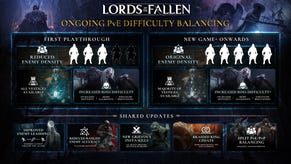UemeU puts a world of creation in your hands - interview
UemeU is the new game-builder that looks to shake up an arena dominated by Minecraft. Can it offer a new alternative to Mojang's voxel template? VG247's Dave Cook spoke with the team at Omnigon Games to find out.
The freedom to creative in videogames have grown dramatically over the last decade. From simple decals on your favourite car, to custom levels and even full games themselves, developers continue to place an increasing degree of power and expression in your hands. LittleBigPlanet was arguably the first mainstream breakthrough in the field proving that anyone with an eye for design and time on their hands could create something magical. Today, Minecraft dominates the creation pack, but something new is building, something called UemeU.
Pronounced "you-me-you," the project was conceptualised and prototyped by David Kaskel, co-founder of recently-named Omnigon Games. It's now in-development under the guidance of fellow studio co-founder, CEO and project lead Jeremy Hindle, and he recently gave me a guided tour around UemeU's creation suite and pre-crafted environments. The idea was to create a tool-set unshackled from the voxel format, and one that evolved over time in sync with its community. Where Minecraft deals purely in blocks, Omnigon's format is potentially limitless.
I asked Hindle where the UemeU's inspiration lay, to which he replied, "Minecraft, Garry's Mod, all of that kind of thing. LittleBigPlanet's definitely one as well, particularly people who are willing to build in that, as our building tools are a lot more flexible than that. I got very frustrated with the building tools in LittleBigPlanet but I love the concept; that I could go and play anyone's world whenever I wanted. That was amazing.
"The idea is that anyone can create anything, anyone can pop-up their own world instantly and anyone can join that if they choose it to be public or not. The person who sets it up has permission to govern how that world's controlled and set rules on it. The idea is, if you see something in a world which you like, you can select it and save it into your inventory for use later on. In that regard it's very much like Second Life, but there's no money involved, so you don't have to pay £100 or whatever it is to rent an acre in UemeU."
UemeU is a vastly empowering experience, and one that may baffle users if they have trouble thinking bigger than simple platform stages and basic shapes. If that's what takes your fancy, then that's perfectly fine, but the game's tutorial is always there to help you dream a little bigger. When you activate play mode, you'll see your 'UemaN' avatar on screen. You can then run around, pick up and throw objects, activate buttons and jump around as you would in a typical third-person experience. Press 'Tab' however, and you'll switch straight in to Build Mode.
Your first test is to fashion a bridge to help your avatar pass a sheer drop. When in Build Mode your avatar switches to a floating hand. You can fly around and look at your world from any angle, move objects, scale them, snap them together, or even destroy them if you want. Shapes can be as simplistic or as intricate as you please, and then slapped with a range of textures or material effects such as glass. Jumping back into play mode allows you to test our your creations on the fly.
Together, Hindle and I practised making objects in Build Mode while his fellow coders built a detailed house across the map together. UemeU is very much about collaboration, and the coming together of talent, so it is possible to have multiple players building worlds together to speed up the process. While I played around with basic shapes and texture applications, the team had put together a two-floor house complete with windows, textures and various properties in mere minutes. They then detonated it for my amusement, sending debris scattering across the world.
Physics apply here, and that's something which could set UemeU apart from Minecraft. You can fashion breakable walls or structures that collapse on command using the tool-set, as well as moving platforms and machine-like objects with set behaviour called 'Uniques.' Hindle then whisked us away to a Sin City platform game inspired by the visuals of Limbo. It was a race between all players across some fiendish moving walkways that rotated along invisible paths. From a distance, another player viewed the mayhem in Build Mode from a 2D perspective to see who would win. Needless to say, I lost. Badly.
On top of this vast array of tools, you can create particle effects and gadgets, which Hindle compared to Minecraft's high-end creation components like Red Stone and other elements. It breaks a 'Uniques' behaviour into triggers and actions, which can create effects when a player passes a certain point, activates a timer, presses a switch and a host of other variables. This could be as simple as opening a door, or more complex results such as playing new music on cue, changing weather effects or morphing significant elements within the environment. I tested this out by playing a working drum kit fashioned by the team.
This is what makes the world respond to your presence as a player, and it's something Hindle felt was limited in Minecraft. It could also be UemeU's key differentiator. This isn't the only difference between Mojang and Omnigon's properties. Hindle also feels that its competitor has been lax on the community front since Minecraft launched, and this is something he's keen to avoid in UemeU. To him, community, discussion, sharing and collaboration are key. There are already many people putting considerable time into the project and their creations online, but to Hindle, this is merely the start.
"The main goal for UemeU is, we really want to create a nurturing community," Hindle explained. "With Minecraft, I was heavily involved with Bukkit and Minecraft server development. In fact, I was one of the people who contributed towards World Edit and World Guard, which are used on pretty much every Minecraft server which is worth anything these days, and also the permission system before they actually put it into Minecraft itself.
"What I want to do is create a community like that, and allow them to nurture the game in a way that they can talk about what they want. I don't think Minecraft would have become as amazing as it was, unless they had that community. I'm not saying it's because of me - most definitely not - but because of the number of people playing, and they kind of acted as a proxy to their own community. Mojang very rarely directly communicated with anyone, they kind of allowed the community to do it for them, and spoke to few members of the community on a basis.
"We would say 'We'd really like to be able to do this, but we need this to be added to the game so we can write a plug-in for it.' What I would really love, is for our actual studio to directly communicate with the people who are playing our game."
Hindle conceded that there's no way Omnigon could respond to every single community request but it is already listening to players around the world who are tinkering around with what UemeU has to offer and together he hopes it will evolve, improve and prosper for years to come. Can the community ignite something big, powerful and potentially challenging to Minecraft and its ilk? Time will tell of course, but all it will take is for one person to make something truly astonishing for the creative audience to sit up and pay attention.
Much like the inventor stumbling across the missing piece of his brilliant creation, this spark could come from anywhere, at any time. We'll be keeping an eye out for it.
What do you make of UemeU so far? You can buy the alpha build for £6.99 over at the official site.












